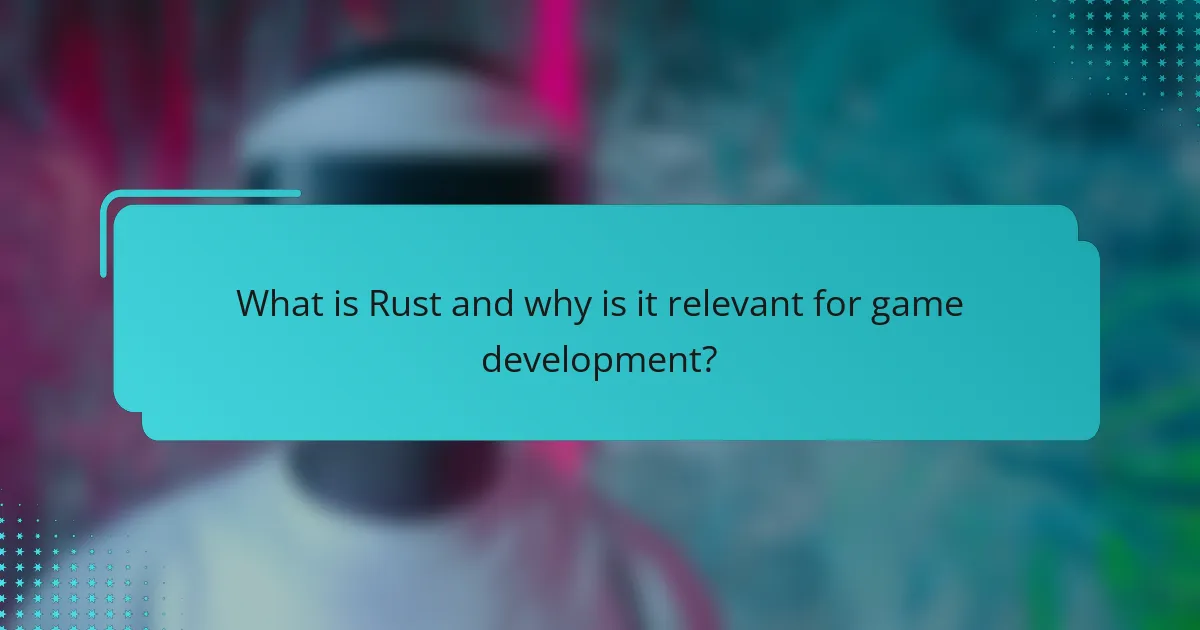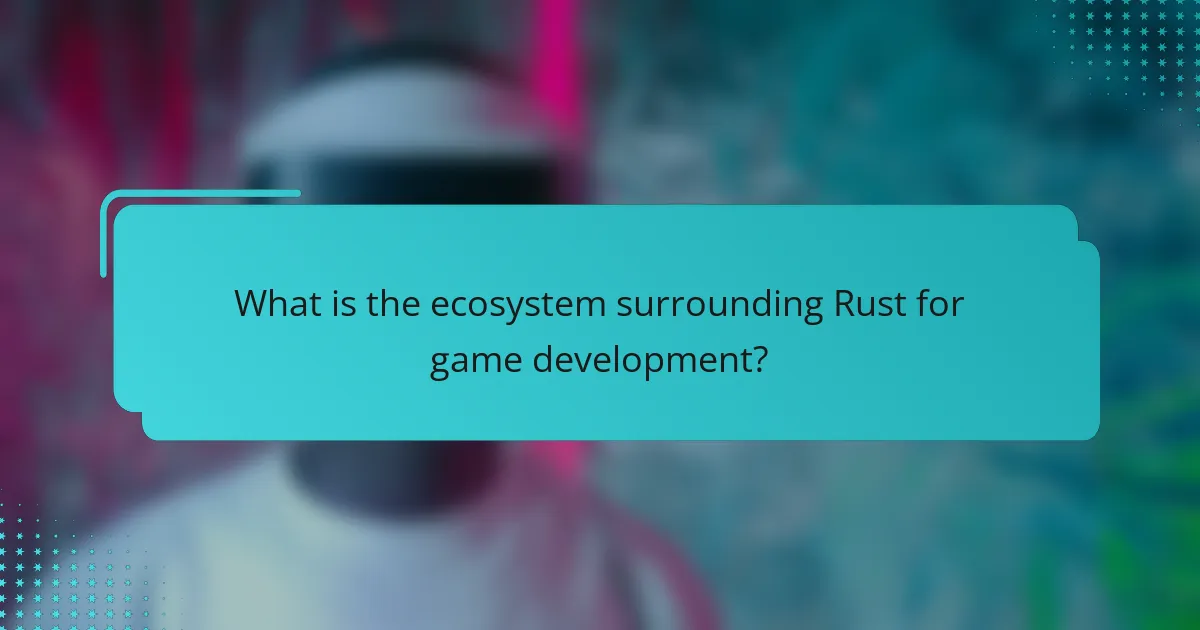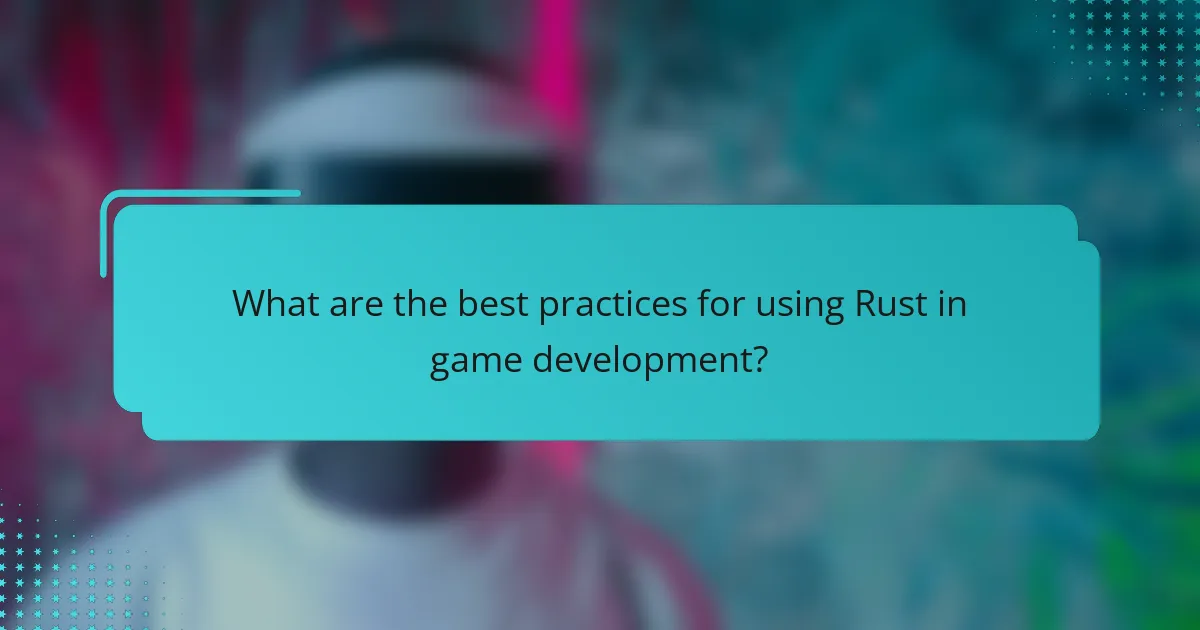
What is Rust and why is it relevant for game development?
Rust is a systems programming language known for its focus on safety and performance. It provides memory safety without a garbage collector, which is crucial for game development. This allows developers to create high-performance applications with fewer runtime errors. Rust’s ownership model ensures that data races are prevented at compile time, enhancing reliability in multi-threaded game environments. Its growing ecosystem includes libraries and frameworks specifically designed for game development, such as Amethyst and Bevy. These features make Rust increasingly relevant for developing modern games that require efficiency and stability.
How does Rust differ from other programming languages used in game development?
Rust differs from other programming languages used in game development primarily due to its emphasis on memory safety and performance. Rust employs a unique ownership model that prevents data races at compile time. This model ensures that memory is managed efficiently without a garbage collector, leading to predictable performance. Unlike languages such as C++ or Java, Rust’s strict compile-time checks eliminate many common bugs. Additionally, Rust’s concurrency features allow developers to write safe multi-threaded code with ease. The language’s tooling, including Cargo for package management, enhances the development experience significantly. Overall, Rust provides a combination of safety, performance, and developer productivity that is distinct from other game development languages.
What unique features does Rust offer for game developers?
Rust offers unique features for game developers, including memory safety, performance, and concurrency. Memory safety is achieved through Rust’s ownership system, which prevents data races and null pointer dereferencing. This system allows developers to write safe code without a garbage collector. Performance is another key feature, as Rust compiles to native code, enabling high-speed execution. Additionally, Rust’s zero-cost abstractions allow developers to use advanced programming techniques without sacrificing performance. Concurrency support in Rust is built into the language, making it easier to write multi-threaded applications. These features collectively enhance the development experience and the quality of games produced with Rust.
How does Rust’s syntax and structure enhance game development?
Rust’s syntax and structure enhance game development by promoting safety and performance. The language employs strict compile-time checks. These checks prevent common bugs such as null pointer dereferences. Rust’s ownership model enforces memory safety without a garbage collector. This leads to efficient memory management, crucial for resource-intensive games. Additionally, Rust’s expressive type system allows for clear and maintainable code. This clarity aids developers in understanding complex systems. Furthermore, the language’s concurrency features enable safe parallelism. This is essential for modern game engines that require multi-threading. Overall, Rust’s design choices directly contribute to building robust and high-performance games.
What safety features does Rust provide for game development?
Rust provides several safety features for game development. Its ownership model prevents data races by enforcing strict rules on memory access. The borrow checker ensures that references are valid without requiring garbage collection. Rust’s type system catches many errors at compile time, reducing runtime crashes. Additionally, pattern matching allows for safer control flow and error handling. These features collectively enhance the reliability of game code. Rust’s focus on safety leads to more maintainable and robust game development practices. The combination of these attributes makes Rust a preferred choice for developers prioritizing safety.
How does Rust ensure memory safety without a garbage collector?
Rust ensures memory safety without a garbage collector through its ownership system. This system enforces strict rules about how memory is accessed and managed. Each piece of data has a single owner at any time. When the owner goes out of scope, the memory is automatically freed. Rust uses borrowing to allow temporary access to data without transferring ownership. Borrowing can be either mutable or immutable, but not both at the same time. This prevents data races and ensures safe concurrent access. The compiler checks these rules at compile time, eliminating many runtime errors related to memory. This design allows Rust to provide memory safety guarantees without the overhead of a garbage collector.
What role do ownership and borrowing play in Rust’s safety features?
Ownership and borrowing are fundamental to Rust’s safety features. Ownership ensures that each value in Rust has a single owner, preventing data races and memory leaks. This system enforces rules at compile time, ensuring memory safety without a garbage collector. Borrowing allows references to data without transferring ownership. This prevents dangling pointers and ensures data integrity during concurrent access. The combination of ownership and borrowing creates a unique memory management model. This model enforces strict lifetimes for variables, which helps avoid common programming errors. Rust’s safety guarantees are a direct result of these principles, making it suitable for game development where performance and reliability are crucial.
What performance benefits can developers expect from using Rust?
Developers can expect significant performance benefits from using Rust. Rust provides memory safety without a garbage collector, which leads to faster execution times. Its zero-cost abstractions allow developers to write high-level code without sacrificing performance. Rust’s strong type system helps catch errors at compile time, reducing runtime crashes and improving efficiency. The language’s concurrency model enables safe parallelism, which can enhance performance in multi-threaded applications. Additionally, Rust’s ownership model ensures efficient memory management, minimizing overhead. These features collectively contribute to creating high-performance applications, making Rust a compelling choice for developers aiming for optimal performance.
How does Rust’s performance compare to other languages in game development?
Rust’s performance in game development is competitive with languages like C++ and C#. Rust offers memory safety without garbage collection, which can enhance runtime performance. Its zero-cost abstractions allow developers to write high-level code that compiles to efficient machine code. Benchmarks show that Rust can match or exceed the performance of C++ in various scenarios. Additionally, the Rust compiler optimizes for performance, enabling efficient resource management in games. This combination of safety and speed makes Rust a strong contender in the game development landscape.
What optimizations can be achieved with Rust for game performance?
Rust can achieve significant optimizations for game performance through its memory safety features and zero-cost abstractions. Memory safety prevents common bugs like buffer overflows and data races, which can degrade performance. Rust’s ownership model allows for efficient memory management without garbage collection overhead. This leads to faster execution times and lower latency in games. Additionally, Rust’s concurrency model enables safe parallelism, allowing developers to utilize multi-core processors effectively. The language’s powerful type system also reduces runtime errors, leading to more stable and performant code. Overall, these features contribute to enhanced game performance and reliability.

What is the ecosystem surrounding Rust for game development?
The ecosystem surrounding Rust for game development includes various libraries, frameworks, and tools. Key libraries include Piston, Amethyst, and Bevy, which facilitate game creation. These libraries provide functionalities such as graphics rendering, physics simulation, and input handling. Rust’s package manager, Cargo, simplifies dependency management and project setup. The community actively contributes to open-source projects, enhancing the ecosystem. Additionally, Rust’s focus on safety and performance attracts developers seeking efficient game solutions. Resources like the Rust GameDev Working Group support collaboration and knowledge sharing. This ecosystem continues to evolve, driven by community engagement and technological advancements.
What libraries and frameworks are available for game development in Rust?
Amethyst, Bevy, and Piston are popular libraries and frameworks for game development in Rust. Amethyst is an open-source game engine that emphasizes data-driven design. It provides a robust architecture for developing 2D and 3D games. Bevy is another game engine that focuses on simplicity and performance. It utilizes an entity-component-system architecture, making it suitable for various game genres. Piston is a modular game engine that supports 2D graphics and game development. It offers flexibility through its various components, allowing developers to choose what they need. These frameworks leverage Rust’s safety features and performance benefits, making them ideal for game development.
How do these libraries enhance the game development process?
Game development libraries enhance the process by providing pre-built functionalities and tools. These libraries simplify complex tasks like graphics rendering, physics simulation, and input handling. They enable developers to focus on unique game mechanics rather than foundational code. Enhanced productivity results from reduced development time and fewer bugs. Libraries often include optimized algorithms, improving performance and efficiency. For instance, libraries like Amethyst and Bevy leverage Rust’s safety features, preventing common programming errors. This leads to more stable game applications. Additionally, an active community supports these libraries, offering resources and documentation for developers.
What are some popular game engines that support Rust?
Some popular game engines that support Rust include Amethyst, Bevy, and Piston. Amethyst is a data-driven game engine designed for parallelism and performance. Bevy is an open-source engine that utilizes an Entity-Component-System architecture. Piston is a modular game engine focused on flexibility and ease of use. These engines leverage Rust’s safety features and performance benefits, making them suitable for game development.
How does the Rust community support game developers?
The Rust community supports game developers through various resources and collaborative efforts. It offers comprehensive documentation and tutorials tailored for game development. The community maintains libraries like Amethyst and Bevy, which simplify game creation. Active forums and chat platforms facilitate real-time assistance and knowledge sharing. Many developers contribute to open-source projects, enhancing tools and frameworks. Regular community events and game jams foster collaboration and innovation. These initiatives create a supportive environment for learning and development in game programming.
What resources are available for learning Rust in the context of game development?
Resources for learning Rust in the context of game development include online courses, books, and community forums. Courses such as “Rust for Game Development” on platforms like Udemy provide structured learning. The book “Game Programming in Rust” offers practical examples and insights. The Rust community on Reddit and Discord serves as a valuable forum for discussion and troubleshooting. Additionally, the official Rust documentation includes sections on game development. Websites like Rust Gamedev provide tutorials and resources tailored for game developers. These resources collectively support learning and application of Rust in game development.
How can developers contribute to the Rust game development ecosystem?
Developers can contribute to the Rust game development ecosystem by creating libraries and frameworks. They can develop game engines that leverage Rust’s safety and performance features. Contributing to open-source projects enhances collaboration and knowledge sharing. Developers can also write documentation to help others understand Rust in game development. Participating in community events fosters networking and skill development. They can report bugs and suggest improvements to existing tools. Engaging in forums and discussions promotes best practices and innovation. Finally, creating tutorials and educational content can help onboard new developers into the ecosystem.

What are the best practices for using Rust in game development?
Use Rust’s ownership model to manage memory safely and prevent leaks. This model enforces strict borrowing rules. It helps avoid data races in concurrent programming. Leverage Rust’s powerful type system for error handling. Use enums and pattern matching for clear, expressive code. Optimize performance by using zero-cost abstractions. Rust’s compile-time checks reduce runtime errors. Utilize existing game development libraries like Amethyst and Bevy for rapid development. These libraries provide frameworks and tools tailored for game development. Embrace community resources and documentation for learning best practices. Engaging with the community fosters knowledge sharing and problem-solving.
What common challenges do developers face when using Rust?
Developers face several common challenges when using Rust. One significant challenge is the steep learning curve associated with its ownership model. This model requires developers to understand concepts like borrowing and lifetimes, which can be complex for newcomers. Additionally, Rust’s strict compiler checks can lead to frustration during the development process. These checks are designed to ensure memory safety but may slow down initial progress.
Another challenge is the limited ecosystem compared to more established languages like C++ or Java. While Rust’s libraries are growing, they may not cover all use cases, necessitating additional work. Furthermore, debugging in Rust can be more difficult due to its compile-time error messages, which some developers find less intuitive.
Lastly, integrating Rust with existing codebases written in other languages can pose compatibility issues. Developers often have to navigate foreign function interfaces, which can introduce complexity. These challenges highlight the need for developers to invest time in mastering Rust’s unique features to fully leverage its benefits.
How can developers effectively troubleshoot issues in Rust game projects?
Developers can effectively troubleshoot issues in Rust game projects by utilizing built-in debugging tools and techniques. They should use the Rust compiler’s error messages to identify syntax and type errors. The Rust Language Server (RLS) can provide real-time feedback and suggestions. Developers can also employ logging libraries like `log` or `env_logger` to track runtime behavior. Testing frameworks such as `cargo test` allow for unit and integration tests to catch issues early. Profiling tools like `cargo flamegraph` help identify performance bottlenecks. Additionally, engaging with community forums and resources can provide insights and solutions from experienced developers. These methods enhance the debugging process and lead to more stable game projects.
What strategies can enhance productivity when developing games in Rust?
Utilizing Rust’s powerful type system enhances productivity in game development. This system helps catch errors at compile time, reducing runtime bugs. Employing Cargo, Rust’s package manager, streamlines dependency management and project organization. Leveraging community libraries like Amethyst or Bevy accelerates development by providing pre-built components. Writing tests alongside code ensures functionality remains intact during updates. Integrating Rust’s concurrency features allows for efficient multi-threading, improving performance. Utilizing documentation tools like rustdoc fosters better code understanding and collaboration. Following these strategies leads to more efficient and effective game development in Rust.
What are some tips for getting started with Rust in game development?
Start by learning the Rust programming language fundamentals. Familiarize yourself with its syntax, ownership model, and memory safety features. Utilize online resources such as the official Rust book and tutorials. Explore game development libraries like Amethyst and Bevy, which provide useful frameworks. Join Rust communities and forums to seek help and share experiences. Experiment with small projects to apply your knowledge practically. Review existing open-source games written in Rust for inspiration and learning. Regularly practice coding to build proficiency and confidence in Rust.
What should beginners focus on when learning Rust for game development?
Beginners should focus on understanding Rust’s ownership model and memory safety features. The ownership model ensures that memory is managed safely without a garbage collector. Learning how to use borrowing and lifetimes is crucial for effective memory management. Beginners should also explore Rust’s concurrency model for safe parallel programming. Familiarizing themselves with the Cargo package manager is essential for managing dependencies and building projects. Additionally, beginners should practice using game development libraries like Amethyst or Bevy. These libraries provide tools and frameworks to simplify game development in Rust. Engaging with the Rust community through forums and open-source projects can enhance learning and provide support.
How can developers build a strong foundation in Rust for future projects?
Developers can build a strong foundation in Rust by mastering its core concepts and features. First, they should familiarize themselves with Rust’s ownership model, which ensures memory safety without a garbage collector. Understanding borrowing and lifetimes is crucial for managing references effectively. Developers should also practice writing idiomatic Rust code by following community guidelines and conventions. Engaging with the Rust community through forums and events can provide valuable insights and support. Additionally, leveraging Rust’s extensive documentation and resources, such as “The Rust Programming Language” book, can facilitate deeper learning. Finally, building small projects or contributing to open-source Rust projects can solidify their skills and understanding.
Rust is a systems programming language that emphasizes safety and performance, making it increasingly relevant for game development. This article explores Rust’s unique features, including its ownership model, memory safety, and concurrency support, which enhance reliability and efficiency in game applications. It also examines the performance benefits of using Rust compared to other programming languages, highlights key libraries and frameworks in the Rust game development ecosystem, and discusses best practices for developers. Additionally, the article addresses common challenges faced by developers and offers strategies for troubleshooting and enhancing productivity in Rust game projects.